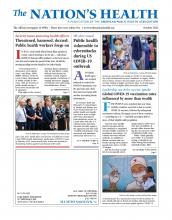
HIV testing in primary care settings can increase the number of people screened for the virus, according to an AJPH study.
Photo by Daniel Balakov, courtesy iStockphoto
HIV testing needed in primary care
Testing for HIV in primary care settings can substantially increase the number of people screened for the virus, a study in the August issue of APHA’s American Journal of Public Health finds.
Researchers used data from the 2019 Behavioral Risk Factor Surveillance System to determine how often adults in the U.S. have been tested for HIV and the missed opportunities to test adults who had never been screened for the virus.
They found that nearly 50% of Americans had been tested at some time, while over 34% had a routine checkup in 2019 but had never had a HIV test. Missed screening opportunities for HIV were highest for people ages 35 to 54, Blacks, women, people without health insurance and people with risk behaviors for HIV.
One in seven people with HIV in 2018 were unaware of their status, the Centers for Disease Control and Prevention estimates.
“Continued efforts to promote HIV testing, including implementing routine screening in clinical settings, will help ensure that all U.S. adults know their HIV status,” the study said.
Classifying improves for opioid deaths
Classification of U.S. opioid overdose deaths has improved over the last two decades. But for people of color, the improvement has been only in recent years, a study in July’s AJPH finds.
Researchers examined data on deaths that involved narcotics that were collected by medical examiners and coroners between 1999 and 2018. The data came from the National Vital Statistics System and the Centers for Disease Control and Prevention. They found that in 1999, opioid overdose deaths were misclassified over 32% of the time, but by 2019 misclassification happened less than 2% of the time.
However, for minority populations, classification of opioid overdose deaths improved only in recent years. Prior to 2012, Blacks were two times more likely than whites to have their deaths involving opioid use misclassified. And prior to 2015, deaths among Hispanics from opioid overdose were misclassified over 10% of the time, compared to those of whites.
Researchers attribute classification improvement to better testing and toxicology reporting.
Border walls do not reduce deaths
Border walls along the U.S.-Mexico line have had no effect on deaths in U.S. counties in the region, a study in July’s AJPH finds.
To conduct the study, researchers examined death records from the National Center for Health Statistics of U.S. border counties from 1999 to 2017. They focused on 10 counties where 548 miles of border were constructed in 2007-2008. Comparing county deaths before and after wall construction, they concluded that the walls had no impact on county homicides, deaths from opioid use and all-cause deaths.
“We generally found no statistically significant association between border wall construction and mortality,” the study said.
The findings refute assertions from immigration opponents that border crossings lead to more homicides in the U.S. Researchers said the study may help decisionmakers who are considering border walls in other countries.
Opioid education reduces deaths
During the COVID-19 pandemic in 2020, deaths from opioid use rose nearly 30% compared to the previous year, according to the National Center for Health Statistics. Over 93,000 people died from an opioid overdose last year, mostly from heroin, compared to about 72,000 in 2019.
New research in July’s AJPH finds that despite the alarming increase — which experts attribute to job loss, isolation and economic hardship from the pandemic — overdose education programs save lives when they are utilized.
Researchers examined 87 studies on opioid overdose education programs. They found that participants develop greater knowledge and understanding of opioids, addiction and naloxone, a drug able to reverse overdoses in emergency situations. The programs also provide sufficient training on administering naloxone and help reduce opioid-related deaths.
Opioid overdose education “should be implemented widely in high-risk populations,” the study said.
For more studies and podcasts from AJPH, visit ajph.org.
- Copyright The Nation’s Health, American Public Health Association









